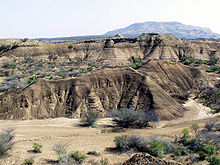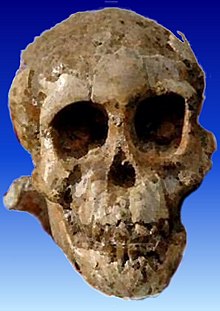Prehistoric Ethiopia
This article may contain verify the text. (January 2023) ) |

Archeological findings

One of the most prominent and precursor excavations in Ethiopia was conducted by
Between 1967 and 1974, the

In 1974, American paleoanthropologist
Between 1992 and 1994, a team led by paleoanthropologist

In 2000, scientists led by paleoanthropologist Zeresenay Alemseged discovered a veiled 3.3-million-year-old Australopithecus afarensis baby nicknamed "Selam". Searches continued in 2001 when Yohannes Haile-Selassie discovered fossils of a 5.2-million-year-old Ardipithecus ramidus family, 15 mi (24 km) from Aramis. Recently, Yohannes has also found fossil specimens of human ancestors in the Afar Region.[5]
Human settlements
Neolithic Revolution
During the Late Stone Age in 9000 BCE,[6] there were at least two bladelet-making archeological cultures in Greater Ethiopia:[7] the Wilton culture (small stone blades) and the Hargeistan (long obsidian bladelet).[8] Humans associated with these cultures were semblance of "Afro-Mediterranean", while there is no Khoisan and Negroid population in the region.[9][10][clarification needed]
It is unclear whether or not these people[
The early inhabitants of Ethiopia began domesticating grains during the
Ethnolinguistic diffusion
This section has multiple issues. Please help improve it or discuss these issues on the talk page. (Learn how and when to remove these template messages)
|

Linguistic analysis indicates that proto-Ethiopians spoke Hamito-Semitic or Afroasiatic languages in the third millennium BCE; these languages probably originated from the Eastern Sahara after its desertification.[14] In the 1950s, scholars agreed that only the Afroasiatic language was an ancestor of five[inconsistent] major languages: Ancient Egyptian, Berber, Semitic, and Cushitic.[15] Harold Fleming proposed including a sixth language group, Omotic (previously considered a branch of Cushitic), and speculated that the Afroasiatic homeland might be in southwestern Ethiopia.
The split between proto-Cushitic and proto-Omotic began by the fourth or fifth millennium BCE, and proto-Semitic separated to
- Northern Cushites – known by the ancient Greeks as "Blemmyes" or "Beja", they developed a single dialect cluster called "Bedawie". They lived as nomadic pastoralists in the desert lowland of the Red Sea in northern Ethiopia and Eritrea.
- Central Cushites – they spoke the dialect cluster "Agaw" and occupied northwestern Ethiopia. Their culture and language are thought to be spoken within an enclave. They are known for the plow cultivation of cereal grains.
- Eastern Cushites – they lived southwest of the East Cushitic language were split among two dozen tribes. These people practiced hoe cultivation of cereal grains and tubers, and terraced agriculture advanced for ancient times. They, along with neighboring people in northern Kenya, are known for distinct social organizationsystems with classes recruited through a fixed cycle of grades and intervals.
- Semitic speakers of Ethiopia – their origin is generally obscured. By the first millennium BCE, the group was split into two branches: the northern plateau region and the central part of the country. The group consists of seven ethnic clusters with varying characteristics (such as size, customs, and lifestyle).
- Omotic speakers in southwest Ethiopia – they practiced hoe cultivation of cereal grains and tubers, and are known for their ritual monarchy. The Omotic is considered the most diversified society, being divided into fifty subgroups with distinct languages and cultures.[17]
The Nilotic peoples of Sudan migrated to Greater Ethiopia in different phases. Pre-Nilotes arrived in Ethiopia about the third millennium BCE. They were mostly agriculturalists who developed the cultivation of sorghum and tuberous plants like enset and yams. Today, they are settled in western parts of Ethiopia namely Berta, Gumuz, and Koma. The second phase of Nilotic migration took place in the first millennium BCE. They are marked by cattle raising, millet cultivation, and dualistic social organization. Their settlement constitutes the western periphery of Ethiopia. The Nilotic represents two tribes, known as Anyuak and Nuer.[18]
Further reading
- Simoons, Frederick J. (1965). "Some Questions on the Economic Prehistory of Ethiopia". The Journal of African History. 6 (1): 1–13. S2CID 162726534.
- Pankhurst, Richard (February 14, 2001). The Ethiopians: A History. Wiley-Blackwell. ISBN 978-0631224938.
- Finneran, Niall (2007-11-08). The Archaeology of Ethiopia. Routledge. ISBN 978-0-429-23647-1.
- Wilding, Richard (1976). Prehistory and the Study of Social Structures of the Past. OCLC 220076226.
References
- ^ S2CID 1454595.
- ^ ISBN 978-1-78477-099-0.
- ^ "Pre-Historic Ethiopia". 2021-11-29. Archived from the original on 29 November 2021. Retrieved 2022-04-23.
- ^ "Ardipithecus ramidus". The Smithsonian Institution's Human Origins Program. Retrieved 2022-04-26.
- ISBN 978-1-5026-2211-2.
- ISBN 978-1-136-14330-4.
- ISBN 978-0-226-47561-5.
- S2CID 162763229.
- ^ a b c Levine 2000, p. 27.
- S2CID 233600844.
- ^ Gish, Steven; Thay, Winnie; Latif, Zawiah Abdul 2016, pp. 23.
- JSTOR 529396.
- ^ "Prehistoric Cultural Development". 2021-11-24. Archived from the original on 24 November 2021. Retrieved 2022-04-23.
- ISBN 978-1-85109-555-1.
- JSTOR 1454381.
- ^ Levine 2000, p. 28.
- ^ Levine 2000, p. 29.
- ^ Levine 2000, p. 31.
